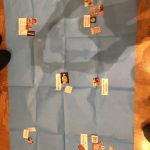From your colleague Josie Owens, some information on the current installation in Gallery 261 of Robert Rauschenberg’s Opal Gospel:
“On 24 January 2018, I met with Jill, Deb, Kara, and Ann at the Opal Gospel.
· Jill explained the process for the installation. She said that Rauschenberg did not use his Native American background as Jimmie Durham had. However, there were some issues around it. She gave us some information about the Cherokee people and their regulations for self-identification. There has been a problem with many celebrities wrongfully claiming Cherokee heritage. She said that this exhibit was supposed to make one think about how picking when to self-identify is a luxury that Native Peoples do not have.
· She said that 5 scholars couldn’t identify Rauschenberg’s Cherokee ancestry. However, sometimes Cherokees would claim to be white in order to buy land and that this could be a possibility for his grandmother. There had not been a decisive conclusion that she wasn’t.
· Then she shared her interaction with the director of the Rauschenberg Foundation, Kathy Halbreich. Kathy had seen the images of the installation with the quotations. Jill said that she told Kathy that she thought that Rauschenberg would have liked this as he enjoyed the discussion and debate. Kathy agreed.
· I then mentioned that I wished that there were more explanation. I said that I felt that there was so much Cherokee information when in fact the texts used by Rauschenberg were all by other Native American people. I worried that this was a bit misleading. Jill was immediately receptive and suggested that more labels be added identifying the writings themselves.
· Jill even shared that she felt that Boney, who had known Rauschenberg and liked him, had a more inclusive statement than Tehee. She seemed to agree with my concern that Tehee’s comment did not help with an open discussion.
· Then we all discussed that if the purpose of the installation was to ask the question what is cultural appropriation and if this is an example or not, then perhaps a sign with that idea should be added. We said that this would help the average viewer especially without a docent.
· Jill was eager to do and said it could be similar to what is happening in period rooms. She suggested something that said that this is a curatorial decision and only one of many approaches.
· We left it that Jill would speak with Juline and circle back.
· The other suggestion Jill had was to get the image of the beautiful metal box that the Opal Gospel comes in. I will do this and share.
Jill was so approachable and open-minded. It was a wonderful discussion and helped so much with my ability to use the art.”
